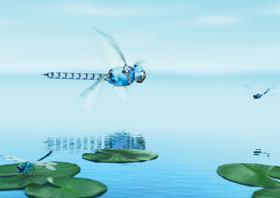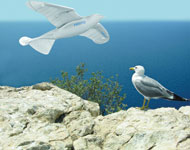

For the first time in South Africa, two revolutionary bionic innovations were on display at the prestigious World Congress of the International Federation of Automatic Control (IFAC) held recently in Cape Town. Delegates were treated to an impressive flying show by Festo’s SmartBird, based on the herring gull, and BionicOpter, based on the dragonfly. They also caused a sensation when they took to the air on the UCT campus. These innovations form part of Festo’s Bionic Learning Network (BLN), which takes inspiration from nature to engineer replicas of natural systems. Motion Control spoke to Dr Heinrich Frontzek, Festo’s head of corporate communication, to find out more.
“Our goal is to motivate, inspire and kick-start innovation, and to contribute to the automation of tomorrow. We want to reach young people though bionics and motivate them to choose engineering as a career.” explains Frontzek. “We take a natural model, find the technical principle behind it, adapt it to a technical platform and demonstrate the technology.” The BLN comprises a small core team of industrial engineers, designers, biologists and control specialists. They coordinate the bionic projects, which are linked to Festo’s products, and work with R&D or external development partners, as well as specialists in universities, students and independent inventors. The group is totally free to develop ideas and share them. These give impetus to new industrial applications. He adds that these bionic innovations are not for sale but rather form a technological platform for Festo to demonstrate its technologies.
He continues: “At the starting point of a project we present an idea at the Hanover Fair, which has a huge international audience, to get feedback from the market. We enter into dialogue with our customers to see where there are applications we did not know about. We apply new concepts to our own products and sometimes we get new products out of these ideas. Some of our projects are far from realisation, but it’s important to be free and open-minded and to have no limits.”

The SmartBird is based on the flight of the herring gull. The wings don’t only go forward but also have an upward thrust due to the integration of propulsion and active torsion. The torsion of the flapping motion has to be synchronised using online condition monitoring. With a wingspan of two metres and weighing only 450 gm, the SmartBird can fly at 25 km/h for up to 20 minutes on one cellphone battery. Twisting is carried out by servomotors in the wings, and the combination of flapping and twisting gives 85% aerodynamic efficiency in the wings. “Here we are implementing lightweight construction and functional integration. This paves the way for efficiency in energy consumption,” he adds.
The BionicOpter has a wingspan of 50 cm and can reach speeds of 45 km/h. Like the dragonfly, it can carry out very complicated flight manoeuvres. It can accelerate rapidly, make sharp turns, break abruptly and even fly backwards as each wing moves separately. This highly integrated motion has been automated to the point that it can be controlled via a smartphone.
Weighing only 175 g, the lightweight construction was achieved by reducing material use, with many components functioning in an extremely tight space. There are 13 degrees of freedom to control. One main motor moves the four wings and makes them flap up and down. It can also monitor the flapping frequency. At the root of each wing one servomotor defines the angle of attack separately and one changes the amplitude. In addition to the nine motors, several sensors are integrated into the main body. A controller controls the nine motors. The components have their own intelligence. Frontzek says that the BionicOPter has taught Festo how to achieve precise control of wing movement as well as functional integration.
“From these bionics, we have learned new approaches for automation. We can integrate more functions into smaller spaces and our components are getting smarter. We are by far the most important driver worldwide for bionics in companies. Looking to the future, maybe we will have bionic managers as well as engineers, with new separate professions like technical biologist or biological engineer, combined in a marriage of skills. We don’t even know the questions yet,” he concludes.
For more information contact Tracey Swart, Festo, 08600 FESTO, sales.interaction@za.festo.com, www.festo.com
| Tel: | 08600 FESTO (33786) |
| Fax: | +27 11 974 2157 |
| Email: | sales.za@festo.com |
| www: | www.festo.co.za |
| Articles: | More information and articles about Festo |
© Technews Publishing (Pty) Ltd | All Rights Reserved